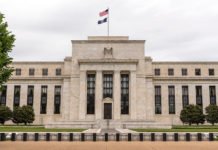As expected, markets were quiet overnight ahead of a deluge of tier-1 earnings, data, and the US FOMC policy decision over the rest of the week. Equity, currency, oil, and precious metals markets were content to range trade, with only Bitcoin showing some life, falling by nearly 6.0%. Bloomberg is reporting that it looks like Coinbase is in trouble with the US SEC over what is a security and what isn’t. Draining the crypto-swamp is going to be a drawn-out process. Oil is rising higher this morning in Asia as energy markets, once again, get caught out by a Russian whipsaw choke hold.
There have been a couple of developments overnight that appear to be weighing on Asia today. Gazprom cut natural gas flows through Nord Stream 1 to around 20% of capacity, citing the usual “technical issues.” That follows the cruise missile attack on Odesa at the weekend, shortly after signing a Turkish-brokered deal with Ukraine to allow the resumption of grain exports. Markets continue to place hope on what Russia says, rather than what it does, when they should be approaching it from the opposite direction. Dutch natural gas prices moved nearly 10.0% higher, but European equities were remarkably resilient; despite a weak German IFO number, I can’t see that lasting.
Late in the US session, retail stalwart Walmart produced a very unimpressive set of results alongside a grim outlook for the rest of the year. Walmart blamed food and energy inflation, reducing consumers’ discretionary spending power, and I can’t argue with that. Today sees Alphabet and Microsoft also announcing earnings, and although there is a lot of nerves around the digital advertising space, I suspect it will be Meta’s results tomorrow that really set the tone. As Meta found out earlier in the year, stock markets are a harsh mistress now if the pandemic-derived growth fantasies can’t be maintained. The same fate surely awaits all three, and Apple this week is that the fairy-tale hits a brick wall. Either way, we are unlikely to see a Wall Street session this week as quiet as the one overnight.
Meanwhile, in China, the announcement of a $44 billion fund by the government to support beleaguered property developers had zero impact on Chinese equity markets yesterday. That could be because China will need to stump up a lot more than $44 billion worth of Yuan to stop the rot. Evergrande, the big distressed-debt kahuna of the space, is approaching an end of July deadline to progress on restructuring its offshore debts. The CEO has been replaced this week, a victim of creative accounting by the group uncovered earlier this year. It looks like the end of July deadline will be a bit of a sea anchor for China equities this week.
Yesterday, Singapore’s inflation data surprised to the upside on both the core and headline readings. We can safely assume that the MAS will be sharpening their pencils for another tightening of monetary policy at their scheduled October meeting, although October seems like a long way away right now.
One bright spot today was South Korean Adv Q2 GDP, which rose by 0.70%, with forecasts expecting a retreat to 0.40%. Strong consumer consumption as covid restrictions eased, were behind the gain. Unfortunately, April-June 2022 is also an age away now, and the picture may have darkened since. I am expecting minimal impact from the data on either the Won or the Kospi.
The Thailand Balance of Trade and Singapore Industrial Production will be of only marginal interest today. Europe’s calendar is empty except for the Hungarian Central Bank policy decision; markets expect a 0.75% hike to 10.0%. The US calendar is rather more substantial, featuring Case-Shiller House Price Index, New Home Sales, CB Consumer Confidence and Richmond Fed Manufacturing and Services Indexes. In the present environment, with the recession word on everyone’s lips, you’d have to say all that data has downside risks.
The US Government is apparently trying to change the definition of a recession from two consecutive quarters of negative growth. Like governments everywhere, they are in a damage-control mood as inflation soars, making their populaces angry. In many cases, most of that blame should be laid at the feet of Russia and their respective central banks. Bulging with PhDs in economics, they all missed the transitory versus entrenched inflation trade, and now here we are.
Governments get the blame, of course, especially in democracies. The White House’s responses of late, as mid-terms loom, are starting to look desperate and are lacking dignity. Still, US commodity prices have fallen this month, gasoline consumption and pump prices have fallen sharply, and the US-centric WTI complex is looking much more wobbly than Brent crude. They say the best cure for high prices is high prices; perhaps the Democrats will get some good news before the mid-terms, although if job losses have started in earnest, it may still be for nought.
Anyway, I digress. Today’s session in Asia is likely to be erring to the soft side as recession fears mount in the US after Walmart’s results. Europe will be dominated by gas, the US by big tech earnings with a smattering of data. I had said previously that the bear market rally will have its moment of truth at the FOMC, but judgement day could arrive a little earlier. I am still not game to pick how this week finishes and will happily watch the circus from the upper-tier seats.
One last thing, and I know I must be boring readers now, but it’s important, and it’s China. Reuters has reported overnight that authorities had ordered 100 large firms in Shenzhen into closed loop systems to counter covid and keep the factories going. Once again, covid-zero means covid-zero, not covid-zero once and done. If push comes to shove, I have no doubt that China will engage in large-scale lockdowns once again if it can’t get on top of its covid outbreaks. Bottom fish China if you wish, and if you have a long-term view, why not? But be prepared for an exciting ride along the way, as the light at the end of the 2022 tunnel could be the train coming the other way: possibly carrying officials to an Evergrande creditors meeting.
Asian equity markets are slightly softer after Walmart results
US markets had a mixed session overnight, with the S&P 500 and Dow Jones booking small gains while the Nasdaq fell. Overall, the picture was of continued range-trading, and investors positioning themselves for the earnings run this week, as well as the FOMC. In the Nasdaq’s case, it looked like some trimming of positions ahead of the big-tech earnings releases starting today. The S&P 500 edged 0.10% higher, the Nasdaq fell by 0.43%, and the Dow Jones rose by 0.28%.
The Walmart results also saw Amazon and Target stocks get a beating by association and re-energised recession nerves. That sees US futures falling in Asia. S&P 500 futures are 0.35% lower, Nasdaq futures are down by 0.25%, and Dow futures have fallen by 0.45%. That sentiment has carried over into Asian markets today, which are also having a modestly mixed day, erring towards the downside.
Japan’s Nikkei 225 has fallen by 0.20%, while South Korea’s Kospi has risen by 0.35% after strong GDP data. In China, the Shanghai Composite has edged 0.05% lower, with the CSI 300 adding 0.15% and Hong Kong gaining 0.40%.
Singapore is 0.25% higher, but Taipei has slipped 0.50% lower, and Jakarta and Kuala Lumpur have fallen by 0.40%. Manila and Bangkok have edged 0.25% higher. In Australia, markets are treading water. The All Ordinaries is down 0.10%, with the ASX 200 unchanged.
It doesn’t look like the Asia session will be one to set the world on fire today, especially with a light data calendar. The natural gas situation in Europe means that European equities will struggle to replicate yesterday’s gains. US markets will come down to the Microsoft and Alphabet results with a dash of data for seasoning. I won’t even bother to speculate what the soup will taste like.
Currency markets range-trade overnight
Currency markets range-traded overnight, with very little to show in either the G-10, Asia FX, or EM space. The technical picture on the dollar index, however, is testing the bottom of its rising wedge, and it is shouting that the US Dollar correction lower still has legs. Overnight, the dollar index finished almost unchanged at 106.48 but has moved through the wedge support at 106.40 today, falling 0.18% to 106.29. A daily close under 106.40 signals more losses towards 1.0500 and 1.0350, and it could extend to the 102.50 long-term breakout point. Resistance is at 107.00, 107.30 and 108.00.
EUR/USD was flat at 1.0230 overnight, gaining 0.15% to 1.0237 in Asia. Russian gas woes could limit gains despite the technical picture being constructive. It has resistance at 1.0275, but only a sustained break above 1.0360 would suggest a longer-term low is in place. EUR/USD has support at 1.0150 and 1.0100.
GBP/USD edged 0.35% higher to 1.2040 overnight, rising to 1.2065 in Asia. Sterling has support at 1.1900 and 1.1800, with resistance taken out at 1.2060 today, followed by 1.2200. A close above the 1.2060 wedge formation signals a larger rally to the 1.2400 regions, but it would take a sustained break above 1.2400 to call for a longer-term low by sterling.
With US yields moving sideways overnight, USD/JPY drifted 0.40% higher to 136.65 overnight, where it remains in Asia. A loss of 135.50 sets the scene for a larger downside correction, potentially reaching 132.00. Initial resistance is distant at 138.00, followed by 139.40. The US/Japan rate differential continues to hold USD/JPY in its thrall.
AUD/USD and NZD/USD rose modestly overnight to 0.6960 and 0.6265, where they remain in Asia. They continue consolidating their respective topside wedge breakouts. Only a move back below either 0.6800 or 0.6150 changes the short-term bullish technical outlook. Like AUD and NZD, the Asian FX space was almost unchanged overnight and is in a holding pattern ahead of the main events for the week, starting with US tech earnings this evening.
Russia lifts oil prices
Russia has further reduced gas flows to Germany overnight, which is threatening to unwind oil’s move lower on Nord Stream 1 reopening. As that reality set in, Brent crude rose 1.20% to 104.85, and WTI gained 1.30% to $96.25 a barrel. In Asia, the Russian moves have also spooked local markets, sending prices sharply higher. Brent crude is 1.85% higher at $106.60, and WTI has leapt 1.80% higher to $98.00 a barrel.
Despite the price discount by WTI over Brent widening to near three-year highs, both contracts have futures curves that remain in deep backwardation, signalling that prompt physical supplies remain tight, even if US gasoline stocks are now rising sharply and refining margins are falling. Russia remains the wild card in the energy space, supporting prices, a situation unlikely to change anytime soon. Of the two contracts, WTI looks the more vulnerable, having the greater physical beta to US domestic energy consumption.
Brent crude is approaching significant technical resistance at $108.80, a sustained break of which signals a larger rally targeting $115.00 a barrel. Support is at $101.50 a barrel. WTI has resistance at $100.00, while it once again, bounced off its 200-day moving average (DMA) at $94.85 overnight. Until a sustained break of the 200-DMA occurs, significant topside squeezes by WTI remain entirely possible.
Gold trades sideways
Gold finished 0.45% lower at $1720.00 overnight, edging 0.20% higher to $1723.25 an ounce in another aimless Asian session. The charts continue to suggest that while gold is trying to form a medium-term low, its price action remains underwhelming, and we will have to wait until we get into the meat of the week’s calendar to see if this scenario plays out.
Gold needs to overcome heavy resistance at the $1745.00 an ounce triple top before the gold bugs can really start to get excited. It has support at $1680.00, and then the longer-term support around $1675.00 an ounce zone. A sustained failure of $1675.00 will signal a much deeper move lower targeting the $1450.00 to $1500.00 an ounce regions.












